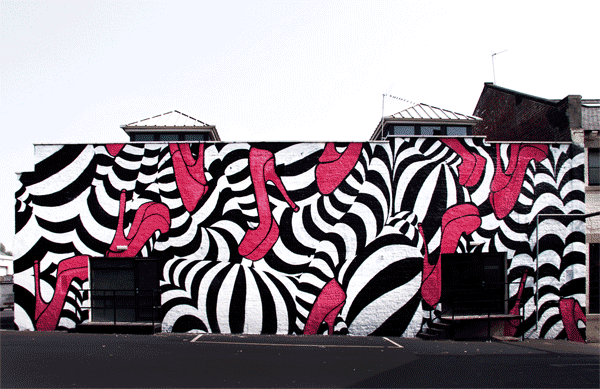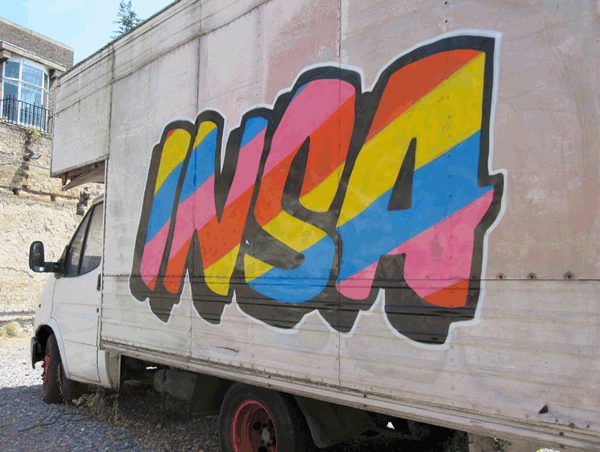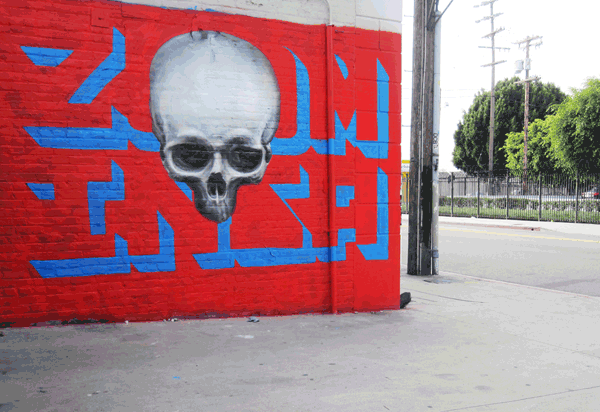
A GIF-iti mural painted by INSA at Unit44 in Newcastle, UK. Animation by INSA.
In a similar vein to Blu’s street animations, some street artists and graffiti writers have turned their art into animated GIFs. As interesting as GIFs of Retna painting can be, that’s not what I mean. A handful of artists, with INSA being the best-known for this and also probably the first to do it, are painting each frame of a GIF onto a wall similar to how Blu paints his animations. INSA calls his animations GIF-iti, and he’s been doing them since mid-2010. For a GIF-iti piece, INSA paints a wall, shoots a photo of it, repaints the wall for the next frame, shoots another photo from the same place, and repeats this process until he has enough frames to make a looping animation. The result are pieces of art that appear to move or light up or be animated in some way while staying in place on a wall.
While you could go and see these GIF-iti pieces in person, since (unlike with Blu’s animations) there is something left to see, the true finished piece is not just the single frame that you might be able to visit but the entire animation, which INSA posts online. The vast majority of graffiti-related GIFs available today are essentially stills from videos that have been turned into short GIFs, but GIF-iti goes beyond that with artwork painted on the street but made for the internet. Unit44’s White Walls Project in Newcastle, UK describes the importance of INSA’s GIF-iti quite well:
“The beauty of INSA’s GIF-iti is that it only truly lives when viewed online, where these days most street art ends up being viewed, and it exaggerates the ephemeral nature of graffiti as each layer is painted instantly over the last. Mixing retro internet technology and labour intensive painting, INSA creates slices of infinite un-reality, cutting edge art for the Tumblr generation.”

Truck GIF-iti painted by INSA. Animation by INSA.
INSA’s GIFs pop when you’re scrolling through Tumblr looking at static photo after static photo of graffiti. While some street artists and graffiti writers reject digital fame as inferior to fame through traditional saturation in the “real world,” it’s the artists who see beyond that who have a chance to use the internet like they have traditionally used subway cars and walls. INSA clearly sees value in fame gained through tumbr likes, and by accepting that unashamedly, he’s been able to push his graffiti forward in a way that fits with the online environment.
Anyone can paint a piece, take a photo and share it, but GIF-iti is something specifically designed for the internet. And that makes sense. Graffiti and street art are about reaching eyeballs and there are more eyeballs interested in his work online than anywhere INSA might paint, so he made something to specifically reach those eyeballs. For many writers, graffiti has always been about communicating to other writers, not the general public. By producing work for an online audience, INSA can directly reach out to that audience of fellow writers and graffiti fans rather than hoping that some small percentage of the people who pass by his GIF-iti murals in person are the people he is hoping to address. Sure, in INSA could also paint in spots like abandoned buildings where most of the people visiting are his target audience, but perhaps nobody will visit. GIF-iti is a form of graffiti where the audience is targeted by interest but not limited by geography. For this reason, INSA’s GIF-iti is one of the most important advances in graffiti and street art in the last decade.
In January 2013, INSA’s work was highlighted on The Atlantic Cities in an article with the headline “Is It Still Street Art If You Can Only See It Online?” In that article, INSA explained his GIFs, saying, “I love the fact [that the Internet] enables me to see new work that is being painted all over the world — I flash through hundreds of amazing creations daily. But in the same breath this means I don’t really take any of the works in.” Rebecca Rosen, the author of the article, also calls INSA’s GIFs “public Internet art,” an important distinction from traditional internet art, and also a phrase that ties the GIFs closely to street art, graffiti and more traditional public art.

A collaborative GIF-iti mural painted by INSA and Kid Zoom in Los Angeles, USA. Animation by INSA.
While INSA is the main person making GIF-iti so far, many of INSA’s GIF-iti pieces are collaborations. He’s worked with Inkie, Kid Zoom, Stanley Donwood, Unga of Broken Fingaz and others. After Unga collaborated on a GIF with INSA, he took the idea to Vienna and collaborated with fellow Broken Fingaz crew member Tant on a piece of GIF-iti (animation was not entirely foreign to Broken Fingaz, as they had previously made this video). GIF-iti is a time intensive process, but as more artists pick up on the idea, it could be one way for street artists and graffiti writers to stay relevant in an increasingly digital world.